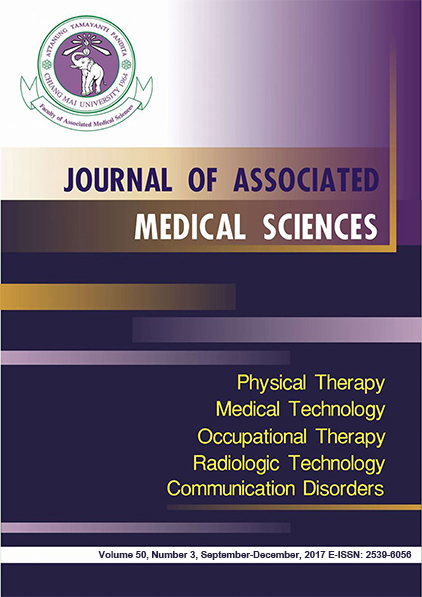Comparative study of the immediate therapeutic effects between modified active release technique and traditional Thai massage on pain alteration in patient with scapulocostal syndrome
Main Article Content
Abstract
Background: Scapulocostal syndrome (SCS) is a common clinical disorder, which consisted of major signs and symptoms including chronic pain of scapular region and myofascial trigger point around scapular muscles. One of common treatment for SCS is manual therapy, such as modified active release technique (mART) and traditional Thai massage (TTM). Both techniques were shown similar therapeutic effects on pain reduction and increased cervical and shoulder range of motion, however, comparison of efficacy is needed for proving.
Objectives: To compare the immediate therapeutic effects between modified active release technique (mART) and traditional Thai massage (TTM) on pain alteration in patients with scapulocostal syndrome.
Materials and methods: Seventy patients with scapulocostal syndrome (16 males, 54 females) were recruited. They were divided into two groups by stratified block random allocation including mART group and TTM group. Treatments of mART or TTM were performed 30 minutes. Pain intensity and pressure pain threshold were investigated before and immediately after treatment. Paired samples t-test was used to determine significant difference within group, while ANCOVA was used to evaluate significant difference between groups, and using a pre-test as a covariate variable.
Results: Comparative results within group, pain intensity was decreased significantly in both groups (p<0.05), while pressure pain threshold was increased significantly in both groups (p<0.05). However, outcome measurements in both groups were shown no significant difference when compared between groups (p>0.05).
Conclusion: mART can improve pain intensity and pressure pain threshold similar to TTM in patients with scapulocostal syndrome.
Article Details
Personal views expressed by the contributors in their articles are not necessarily those of the Journal of Associated Medical Sciences, Faculty of Associated Medical Sciences, Chiang Mai University.
References
2. Cohen CA. Scapulocostal syndrome: diagnosis and treatment. South Med J 1980; 73(4): 433-4, 437.
3. Abrams B. Scapulocostal syndrome. In: Waldman SD, editor. Pain management, 2nd ed. Philadelphia: Saunders; 2011: 588-92.
4. Michele AA, Davies JJ, Krueger FJ, Lichtor JM. Scapulocostal syndrome (fatigue-postural paradox). New York J Med 1950; 50: 1353. Cited by: Abrams B. Scapulocostal Syndrome. In: Waldman SD, editor. Pain management, 2nd ed. Philadelphia: Saunders, 2011: 588-92.
5. Simons DG, Travell JG, Simons LS. Myofascial pain and dysfunction: The trigger point manual. Volume 1, 2nd ed. Baltimore: Williams & Wilkins; 1999.
6. Boonprakob Y, Phadungkit S, Nongharnpitak S, Srijessadarak T, Supasatean W, Nakhengrit C. Trigger point: Curable or palliative symptoms. Bull Chiang Mai Assoc Med Sci 2016; 49(1): 155-66.
7. Wannapong N, Boonprakob Y, Chatchawan U, Wanpen S, Phadungkit S. Immediate and short term effect of modified active release technique (mART) in patients with scapulocostal syndrome. Bull Chiang Mai Assoc Med Sci 2016; 49(1): 134-45.
8. Buttagat V, Eungpinichpong W, Chatchawan U, Arayawichanon P. Therapeutic effects of traditional Thai massage on pain, muscle tension and anxiety in patients with scapulocostal syndrome: a randomized single-blinded pilot study. J Bodyw Mov Ther 2012; 16(1): 57-63. doi: 10.1016/j.jbmt.2011.04.005.
9. Borm GF, Fransen J, Lemmens WA. A simple sample size formula for analysis of covariance in randomized clinical trials. J Clin Epidemiol 2007; 60(12): 1234-8. doi: 10.1016/j.jclinepi.2007.02.006.
10. Gallagher EJ, Bijur PE, Latimer C, Silver W. Reliability and validity of visual analog scale for acute abdominal pain in the ED. AM J Emerg Med 2002; 20(4): 287-90.
11. Jones DH, Kilgour RD, Comtois AS. Test-retest reliability of pressure pain threshold measurement of the upper limb and torso in young healthy women. J Pain 2007; 8(8): 650-6. doi: 10.1016/j.jpain.2007.04.003.
12. Fricton J. Myofascial Pain: Mechanisms to Management. Oral Maxillofac Surg Clin North Am 2016; 28(3): 289-311. doi: 10.1016/j.coms.2016.03.010.
13. Mackawan S, Eungpinichpong W, Pantumethakul, R, Chatchawan U, Hunsawong T, Arayawichanon P. Effects of traditional Thai massage versus joint mobilization on substance P and pain perception in patients with non-specific low back pain. J Bodyw Mov Ther 2007; 11(1): 9-16. doi: 10.1016/j.jbmt.2005.11.001.
14. Melzack R, Wall PD. Pain mechanisms: a new theory. Science 1965; 150: 971–9.
15. Field T. Massage therapy research review. Complement Ther Clin Pract 2014; 20(4): 224-29. doi: 10.1016/j.ctcp.2014.07.002.
16. Pickar JG. Neurophysiological effects of spinal manipulation. Spine J 2002; 2(5): 357-71.
17. Jafri MS. Mechanisms of myofascial pain. Int Sch Res Notices 2014; 2014: 523924. doi: 10.1155/2014/523924.
18. Ibarra JM, Ge HY, Wang C, Martínez Vizcaíno V, Graven-Nielsen T, Arendt-Nielsen L. Latent myofascial trigger points are associated with an increased antagonistic muscle activity during agonist muscle contraction. J Pain 2011; 12(12): 1282-8. doi: 10.1016/j.jpain.2011.09.005.
19. Otsuki A, Fujita E, Ikegawa S, Kuno-Mizumura M. Muscle oxygenation and fascicle length during passive muscle stretching in ballet-trained subjects. Int J Sports Med 2011; 32(7): 496-502. doi: 10.1055/s-0031-1275297.
20. Buttagat V, Taepa N, Suwannived N, Rattanachan N. Effects of scapular stabilization exercise on pain related parameters in patients with scapulocostal syndrome: A randomized controlled trial. J Bodyw Mov Ther 2016; 20(1): 115-22. doi: 10.1016/j.jbmt.2015.07.036.
21. Farrar JT, Portenoy RK, Berlin JA, Kinman JL, Strom BL. Defining the clinically important difference in pain outcome measures. Pain 2000; 88(3): 287-94.
22. Manoli I, Alesci S, Blackman MR, Su YA, Rennert OM, Chrousos GP. Mitochondria as key components of the stress response. Trends Endocrinol Metab 2007; 18(5): 190-8. doi: 10.1016/j.tem.2007.04.004.
23. Picard M. Pathways to aging: the mitochondrion at the intersection of biological and psychosocial sciences. J Aging Res 2011; 2011: 814096. doi: 10.4061/2011/814096.


